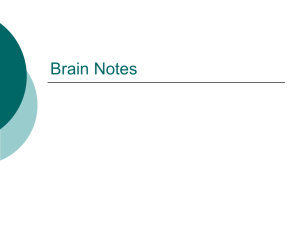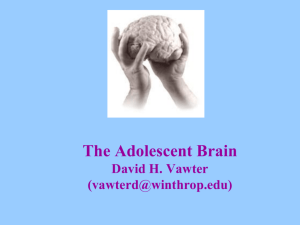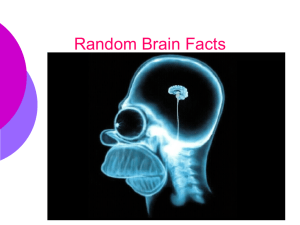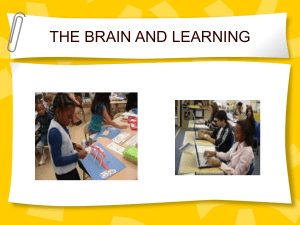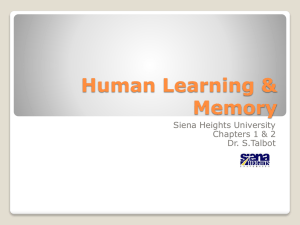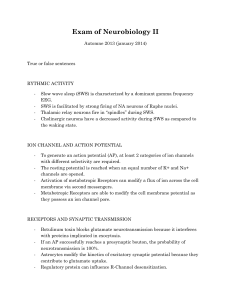File - Conversations
advertisement
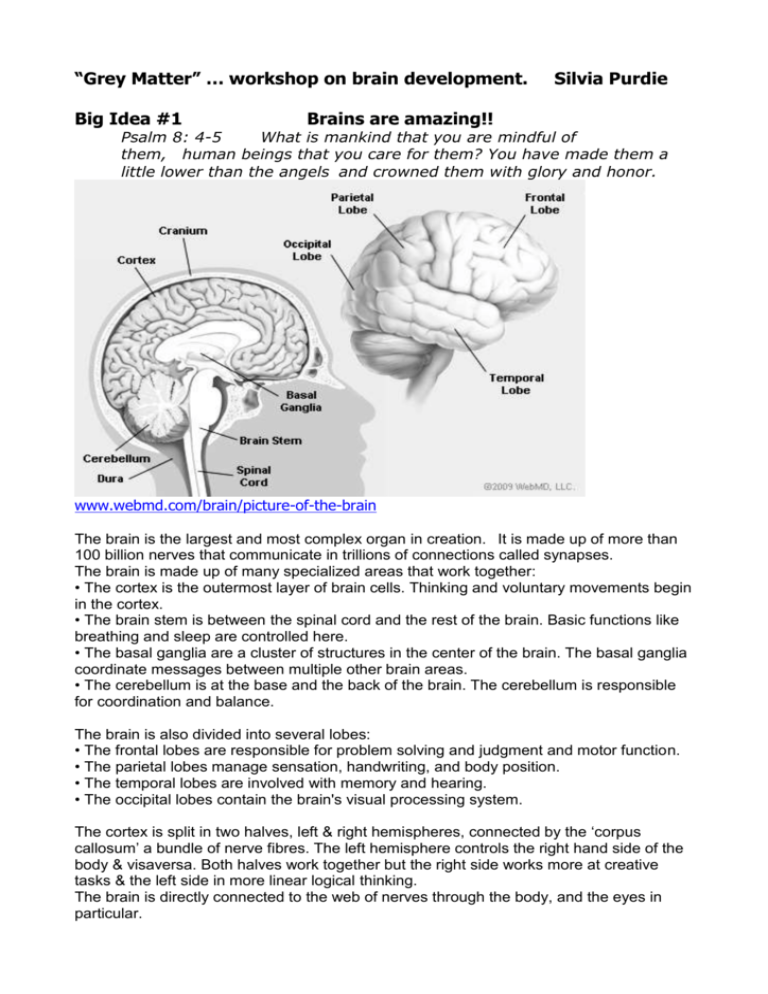
“Grey Matter” … workshop on brain development. Big Idea #1 Silvia Purdie Brains are amazing!! Psalm 8: 4-5 What is mankind that you are mindful of them, human beings that you care for them? You have made them a little lower than the angels and crowned them with glory and honor. www.webmd.com/brain/picture-of-the-brain The brain is the largest and most complex organ in creation. It is made up of more than 100 billion nerves that communicate in trillions of connections called synapses. The brain is made up of many specialized areas that work together: • The cortex is the outermost layer of brain cells. Thinking and voluntary movements begin in the cortex. • The brain stem is between the spinal cord and the rest of the brain. Basic functions like breathing and sleep are controlled here. • The basal ganglia are a cluster of structures in the center of the brain. The basal ganglia coordinate messages between multiple other brain areas. • The cerebellum is at the base and the back of the brain. The cerebellum is responsible for coordination and balance. The brain is also divided into several lobes: • The frontal lobes are responsible for problem solving and judgment and motor function. • The parietal lobes manage sensation, handwriting, and body position. • The temporal lobes are involved with memory and hearing. • The occipital lobes contain the brain's visual processing system. The cortex is split in two halves, left & right hemispheres, connected by the ‘corpus callosum’ a bundle of nerve fibres. The left hemisphere controls the right hand side of the body & visaversa. Both halves work together but the right side works more at creative tasks & the left side in more linear logical thinking. The brain is directly connected to the web of nerves through the body, and the eyes in particular. Sparking neurons Brains have other stuff in them as well, that make up most of the tangible mass: the physical linages (called glial cells), blood stream & protection. But what makes us think are the 100 billion nerve cells, called neurons. These consist of a cell body - nucleus – and its branches - dendrites. Neurons are found throughout the nervous system (brain, spinal cord, periphery) but are most concentrated in the brain. An average neuron has 7000 connections to other neurons, but can have up to 100,000! These dendrites split into complex trees and send & receive signals from other neurons. The neuron and its thousands of neighbours send roots and in all directions, which intertwine to form an interconnected tangle with 100 trillion constantly changing connections. There are more possible ways to connect the brain’s neurons than there are atoms in the universe. The connections guide our bodies and behaviours, even as every thought and action we take changes the dendrite patterns. The connections among neurons and their strengths are not hard-wired. “Learning” is essentially the process of changing connections (“synaptic pruning”) and their strengths (“synaptic plasiticity”). This is often summarized as: “Cells that fire together, wire together.” This explains associative memory: if you repeatedly hear the birthday song while you are simultaneously looking at a birthday cake, eventually whenever you see or think about a birthday cake, you are reminded of the song. Learning is reinforced physically by ‘myelin’ which is a protective coating for the dendrites. This makes some pathways faster and stronger than others without the myelin. Dendrites don’t quite touch each other. The ‘spark’ of thought happens as a flash of electricity jumps the gap between the end of the dendrite (called an axon) & the next neuron. This is called the synapse. Big Idea #2 The first 3 years are the most important Matthew 19:14 Jesus said, “Let the little children come to me, and do not hinder them, for the kingdom of heaven belongs to such as these.” The human brain is the only organ in creation that is not yet developed at birth. A typical newborn baby’s brain weighs just 350g, which grows to 1.2kg in 3 years. It will grow only another 240g during rest of life. So babies and toddlers are actually forming who they are, as the basic structures of the brain are being made every day. Astonishingly, before a baby is born is has already grown DOUBLE the number of neurons that it will need. In the last month or 2 of pregnancy the brain destroys half its brain cells! However, these billions of brain cells we are born with need to be wired up. Baby’s brain signals move slowly (you can tell from those long stares they give you!), but every day they are literally making new connections. Until by age 3 their brains are a crazy maze of connections, brains firing in every direction. A 3-year-old has TWICE as many ‘synaptic connections’ as an adult’s brain. The process of learning after age 3 is actually one of ‘pruning’ these connections, so that we remember what is most relevant and lay down the more fixed pathways that make up our personality, habits, values & actions. Pruning also allows the electrical signals to move faster. A child’s ‘busy brain’ means that is uses about twice the energy of an adult’s brain, a big part of a child’s calorie intake! Physical exercise is very important in providing the brain with enough glucose. Because the young brain prunes weak connections, environmental input in a child’s early years can have either amazing or devastating effects on the brain’s wiring, and thus on future behaviour and abilities. As our brains prune or strengthen connections, they become more set in their ways. For instance, every human baby is able to differentiate every sound in every human language. however, by 6 months old, if a baby has not heard a particular sound, it will no longer be able to distinguish it. By a year old we become functionally deaf to any language other than our own. So what? … how do we enhance the learning environments of babies & preschoolers? Big Idea #3 Stressed kids don’t learn “Do not be afraid” (said 365 times in the Bible, one for each day of the year!) There is a constant see-saw between the brainstem and the cortext. If you perceive that you are under THREAT … the brainstem gets activate, it floods the body with stress hormones (esp adrenaline) … the heart beats faster, blood rushes to your muscles, your body speeds up, your brain focuses on details that may affect your survival. Threat to survival Fight, Flight or Freeze!! You cannot THINK unless your cortext is CALM This happens when you - feel SAFE - feel loved and in good RELATIONSHIP - and when your environment is PREDICTABLE When children are constantly experiencing their safety as under threat, the cortex never gets to develop. The brain on the left is of a normal person. The cortex is lit up, active (front, top), as well as the brainstem doing its job (lower & middle). The brain on the right belongs to a murderer. There is very little activity in the cortext, and more in the lower brainstem triangle. Prefrontal damage has been linked with risk taking, irresponsibility, rule-breaking, emotional and aggressive outbursts, and argumentative behavior—all of which predispose to violent criminal acts. At a social level, the loss of intellectual flexibility, problem-solving skills, and reduced ability to use information provided by verbal cues—all resulting from prefrontal dysfunction—can impair social skills essential for formulating nonaggressive solutions to fractious encounters. http://www.dana.org/news/cerebrum/detail.aspx?id=3066 What makes your brain work LESS well? … Cortisol. Stress hormones wipes out learning as the body gets into flight-flight-freeze … CATS (Caffeine, Alcohol, Tobacco, Sugar) What makes your brain work BETTER? a) Being safe b) Being happy … releasing endorphins. … Physical exercise. Singing So what? … how can we help kids (and adults!) feel safe in our environments? Big Idea #4 The more brain you use, the more you learn Luke 7: 22. Go and tell what you have seen and heard What works your brain the hardest? You have to do something 90 times for the brain connections to be permanent. Brains spark all over AND in specific places. Learning involves language, action, colour, sound … and most of all, relationship! How do we help kids learn? Warm consistent relationships affection mixed media music … Big Idea #5 Brains are made for love! 1 John 2:10. Anyone who loves their brother and sister lives in the light More info … Nathan Mikaere-Wallis (seminar notes from Compass Seminars) Brain info for kids: kidshealth.org/kid/htbw/brain.html# The Dana Foundation has an excellent website: http://dana.org/brain.aspx ‘The Universe Inside You: The extreme science of the human body from Quantum theory to the mysteries of the brain’, by Brian Clegg, 2012 ‘A User’s Guide to the Brain’ by John Ratey, 2001 ‘How the Brain Works: a beginner’s guide to the mind and consciousness’, John McCrone


